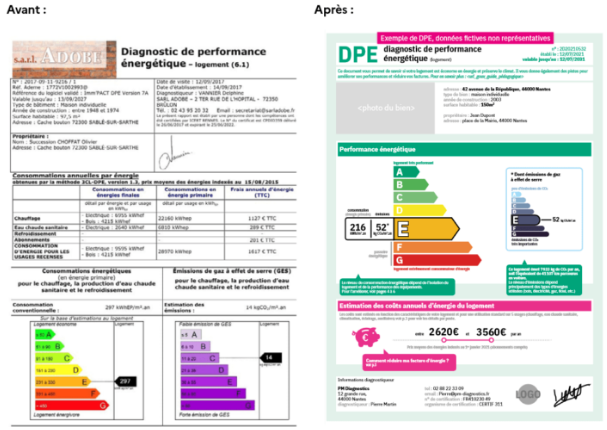New DPE - July 2021: The essential points
The DPE (Diagnostic for Performance of Energy) has been improved. It is now more reliable, readable, and considers climate issues. Released on July 1, 2021, this new energy performance diagnostic is valid for ten years.
Buyers and lessees of a home after July 1, 2021, will, therefore, receive this new DPE.
A derogatory period has been set up for DPEs according to the old system between January 1, 2013, and July 1, 2021. It is defined as follows:
- DPEs dated from January 1, 2013, to December 31, 2017, remain valid until December 31, 2022;
- DPEs dated from January 1, 2018, to June 30, 2021, are valid until December 31, 2024.
As of January 1, 2025, only new DPEs will be valid.
Here are the main differences between the old and the new DPE version:
The new DPE for July 2021: more precise assessments
For the previous energy performance diagnosis, the method consisted of auditing the physical characteristics of the housing (buildings, heating, insulation, etc.). A score from A to F took into account the energy consumption of the dwelling. Greenhouse gas emissions were indicated but not taken into account in the calculation.
From now on, the note of the new DPE of July 2021 considers the consumption of primary energy (energy label) and greenhouse gas emissions (climate label).
The previous DPE based on the energy bills of the previous occupants of the dwelling was unreliable. Therefore, the new method takes the average annual expenditure of 5 energy usage in the home: heating, hot water, lighting, air conditioning, auxiliaries (VMC).
Enhanced information features in the new energy performance diagnostics
Previously, the DPE did not contain detailed information on the energy performance of all elements of a dwelling. From now on, the DPE indicates the positive and negative points of the home in terms of energy consumption: heat loss, insulation performance, ventilation system, and renewable energy production systems (if any). It must also mention the work to be carried out to improve the home's energy performance, specifying whether this work is a priority.
Greater clarity and legibility in the updated DPE
The cover page of the DPE is simplified. It now summarizes the essential information (energy label, climate label, and estimate of annual energy expenditure). In addition, the inside of the document features colors to make it easier to read.

Source : Ministry of Ecological Transition.
Legal implications of the new Energy Performance Diagnostic
This new diagnosis becomes opposable, meaning it is possible to challenge it. In other words, the buyer and tenant can turn against the seller or lessor in case of errors in the energy label.
For example, if an owner sells his property labeled class E when it is a class F or G, it may incur his liability. He will have to carry out energy renovation work. The same sanction applies to landlords of rental accommodations.
Nota Bene: As of January 1, 2021, it is no longer possible to increase the rent for accommodation known as "thermal strainers."
A future ban on classified F or G housing is in progress (in 2025 for G housing, in 2028 for F housing).
Objectives and purpose of regulatory updates to the Energy Performance Diagnostic
The objective of the new diagnosis is to inform the purchaser or the tenant about the energy performance of their future home by calculating the consumption of goods and making owners aware of the importance of energy renovation to preserve our planet.
How does the new July 2021 DPE label look?
The double threshold DPE label provides information on energy consumption and carbon emissions. Therefore, the lower of the two scores is retained as the overall label of the accommodation.
The "Energy" label (calculation of class A, B, etc.) displays primary energy consumption* and greenhouse gas emissions**.
Warning: Goods of class F or more will be rated "energy strainer."
As a reminder, the DPE, like the other elements of the technical diagnostics file, is mandatory in the event of rental and sale. There is one exception, however, for rentals of a duration period under four months.
* Primary energy sources: crude oil, natural gas, solid fuels (coal, biomass), solar radiation, hydraulic energy, geothermal energy, and energy from nuclear fuels.
** Greenhouse Gases (GHGs): natural gases present in the earth's atmosphere trapping the sun's rays and stabilizing the temperature on the planet's surface.
Credits photo@Andrew Pons



 Français
Français


















